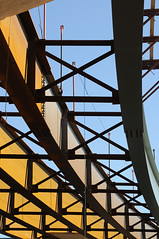
While resting after dinner tonight, two ideas to explore as launching points for my improvisations tonight arose. This is in line with my commitment to Creative Pact 2011. I was fairly certain that the ideas were from Ralph Towner's book Improvisation and Performance Techniques for Classical and Acoustic Guitar. Flipping open my copy to search for these ideas I came across this gem: Density and intensity are not the same thing. The sparsity of notes and again the coloring can maintain and even increase the drama. Suddenly I was letting go of my ideas for a different evening, even though I was unclear as to what I would do. Gotta love stepping into the unknown.
Armed with a vague sense of how to proceed, I hit the floor for my AT lie down. Towards the end of the lie down, I began improvising in my mind. This began with a tri-tone and gently took off. The thought arose that I could begin to improvise in my mind and then play what I was hearing, which would also challenge my ear and fretboard knowledge. So once again, my sense of what I would do this evening had a slight change of course. I began improvising in my mind, and almost as soon as I began playing, I let go of the notion. The hands took over and I allowed them to. What came out was pleasing to me, but I'll never know if it was the act of improvising that was pleasing or the subsequent music.
Because of this I decided to up the ante and break out my mp3 recorder. At the very least I could listen back during my commute to work. I know that listening back is a double edged sword. Harsh judgement could sidetrack otherwise good work from developing. Yet not having a tool for evaluating my work is delusional. Five improvisations followed - two based on Mike Vargas's concept of Zone's; one with an emphasis on dyads; and one with an emphasis on chords based on fourths. The final improv was an effort to vary the intensity of quick burst of dense notes. One thing I noticed in the act of playing with the final improv was that when I focused on intensity of notes, my playing slowed down. More work to follow with all of this.
My work with AT was not as active this evening. I did do another lie down after the first three improvisations and paid attention to myself in between the improvs. Reflecting back on this though during both of the lie downs, I did have thoughts that were pertinent to my musical work for the evening.
Density - Intensity. Wherein lies the balance?
Note: I was pleasantly surprised to see that only a used copy of Towner's book is available on Amazon at a price of $142. Glad I've held onto this. I suspect we'll never see this happen with digital works.

I'm a huge Ralph Towner fan. I didn't even know that he had a book out about improvising on guitar. What a gem it must be! I couldn't agree more with his notion of density and intensity. If we think of sound as a contrast to silence (as opposed to treating silence as if it were "nothing") we open ourselves up to a huge world of expressive possibilities. You're on such a beautiful path here with all this. I can't wait to see where you go with it.
ReplyDeleteNice post - I remember, years ago, a choral director telling us that intense does not mean forte - and piano does not mean lax. She was trying to get us to keep it crisp in the pp sections. In the same way complexity is not necessarily complicated. Simple can be highly complex.
ReplyDeleteReading your post has me want to go over to the piano and play an intense few notes, something deliciously sparse, something from the depths of my heart.
Bill, I am fortunate to have studied guitar within a tradition that values and nurtures silence. I'm not sure if you have visited my website but you may listen to my work there. http://www.PatrickSmithMusic.com
ReplyDeleteKathy,
ReplyDeleteI truly hope you invited your piano to sing from the depths of your beautiful heart. And please do this again and again.